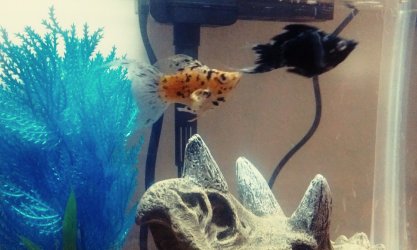DanielaRae
New Member
- Joined
- Oct 26, 2017
- Messages
- 4
- Reaction score
- 0
Hi guys, I'm new to this whole fish keeping world, so I appreciate any help!
I have a 10gallon tank and bought everything from Petco...filter, heater, rocks, ect...I put quick start and api water conditioner in to start and had it running for about a week before adding fish. So far ever single fish I attempted to keep has died. I had a small school of 5 fish (I don't remember what they were) and after a few days they died off. I also had one male sunburst platy and a tiger Barb. I know the tiger bard was a bad idea, but I knew nothing about fish and the guy at the pet store told me the tiger Barb would go well with my platy and fish school. No! The tiger Barb bullied my platy and I caught him eating two of my school fish. So I bagged him up and took him back to the pet store and got my two school fish replaced and a black balloon Molly to replace the tiger Barb. But then, like I said, the rest of my school fish died anyway and so did my platy! For two days my platy would sink to the bottom of the tank and just lay there like he was dead and he didn't eat. I didn't have a way to test my water. I thought it might be because of the bullying. But he ended up dying the next morning. The Molly seemed fine. But I changed out about 50% of the tank water. I also went to petco to have them test my water after the water change. The lady said my water looked really good. So I bought another balloon Molly and a snail to keep my black Molly company. They were following each other everywhere, you could tell they were super happy, eating everything. That was yesterday. Last night my black Molly started acting like the platy....started laying on the bottom of the tank like dead, then get up swim around, then back down. So this morning I did a 95% water change again, even though they said my water was fine. Now my new orange Molly is on the bottom of the tank! He's actually hiding in the cave. My black one seems alittle more alive, but every now and then he'll still lay down too like he's dead. I feel so bad I don't know what's causing this they look completely normal as far as no white spots, no gasping for air....just laying like dead
they look completely normal as far as no white spots, no gasping for air....just laying like dead  any thoughts on what I should do???
any thoughts on what I should do???
I have a 10gallon tank and bought everything from Petco...filter, heater, rocks, ect...I put quick start and api water conditioner in to start and had it running for about a week before adding fish. So far ever single fish I attempted to keep has died. I had a small school of 5 fish (I don't remember what they were) and after a few days they died off. I also had one male sunburst platy and a tiger Barb. I know the tiger bard was a bad idea, but I knew nothing about fish and the guy at the pet store told me the tiger Barb would go well with my platy and fish school. No! The tiger Barb bullied my platy and I caught him eating two of my school fish. So I bagged him up and took him back to the pet store and got my two school fish replaced and a black balloon Molly to replace the tiger Barb. But then, like I said, the rest of my school fish died anyway and so did my platy! For two days my platy would sink to the bottom of the tank and just lay there like he was dead and he didn't eat. I didn't have a way to test my water. I thought it might be because of the bullying. But he ended up dying the next morning. The Molly seemed fine. But I changed out about 50% of the tank water. I also went to petco to have them test my water after the water change. The lady said my water looked really good. So I bought another balloon Molly and a snail to keep my black Molly company. They were following each other everywhere, you could tell they were super happy, eating everything. That was yesterday. Last night my black Molly started acting like the platy....started laying on the bottom of the tank like dead, then get up swim around, then back down. So this morning I did a 95% water change again, even though they said my water was fine. Now my new orange Molly is on the bottom of the tank! He's actually hiding in the cave. My black one seems alittle more alive, but every now and then he'll still lay down too like he's dead. I feel so bad I don't know what's causing this



